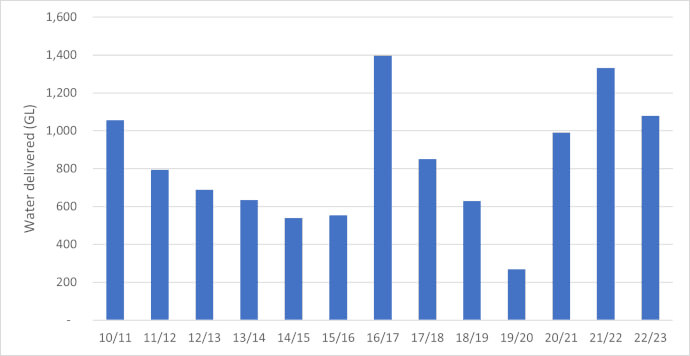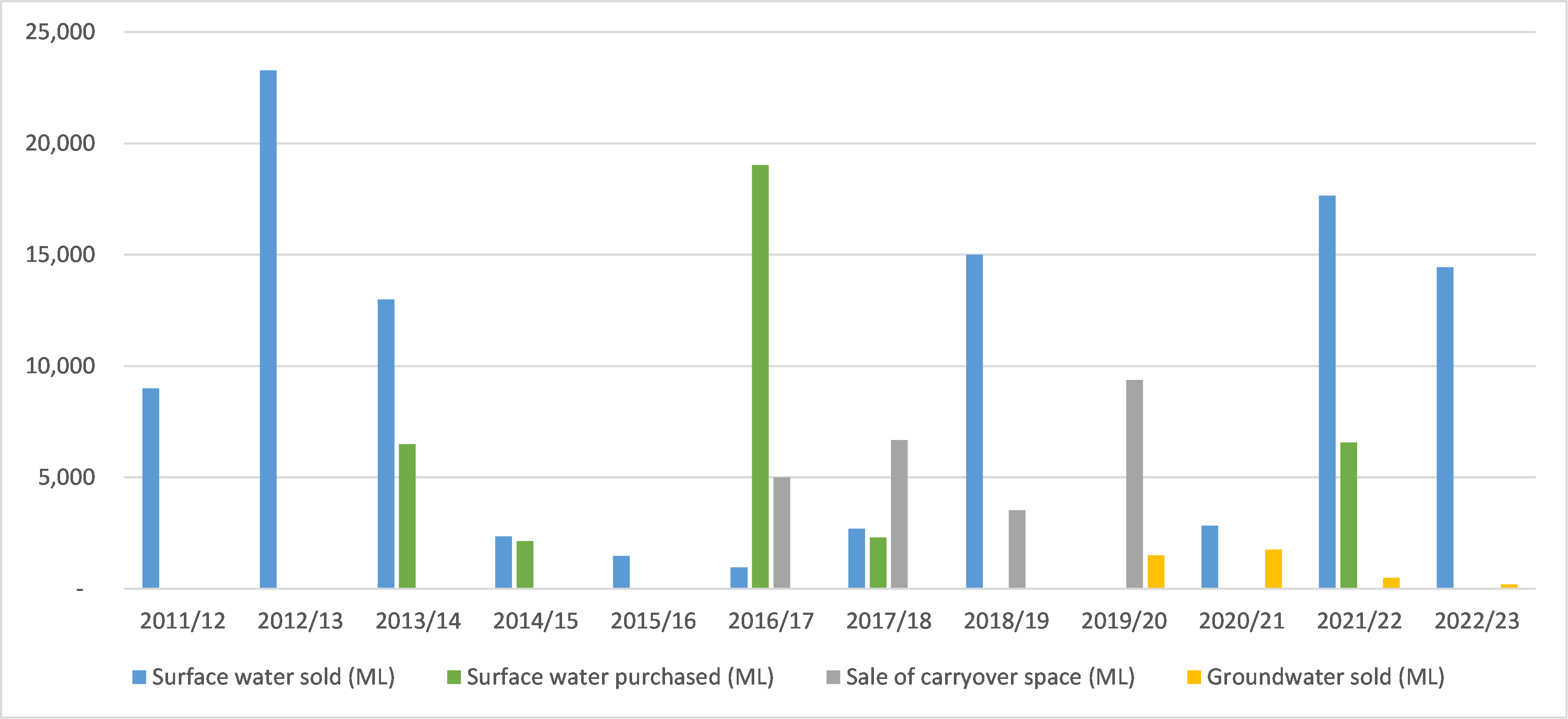The plans outline the priorities for the use of water for the environment in the coming year, depending on climatic factors and water availability.
Environmental flows and trade
During 2022–23, the department capitalised on very wet conditions across the catchments to deliver water for the environment instream and to key wetland and floodplain sites. In 2023–24, water managers plan to supplement existing system flows to provide the maximum benefit to plants and animals. The Water for the Environment team is currently monitoring opportunities to restore a more natural flow pattern to support a robust food web and other system functions.

Annual water use for the environment in the NSW Murray–Darling Basin to 30 June 2023 (GL)
The department also uses the water market to move water to where it is needed most and assist with paying water licence use fees and small infrastructure projects to improve environmental outcomes.
Trades typically commit less than 5% of the water available to the environment and are a small proportion of the total trades made by other market participants. With high water allocations for a fourth consecutive year, there is an opportunity to sell allocation to contribute to the payment of water use fees and environmental projects. The small proportion of water traded is carefully planned to ensure our ability to achieve environmental outcomes is not compromised.
Water trade announcements
This section relates to decisions made solely by the NSW Environmental Water Holder (the department) to trade state-owned allocation. It does not include decisions made by other environmental water holders or joint governments to trade to or from environmental water licences held in New South Wales. Other parties could be:
- the Commonwealth Environmental Water Holder
- private environmental water holders, such as the Murray Darling Wetlands Working Group
- joint governments for water under The Living Murray Program which we trade under instruction from the Murray–Darling Basin Authority.
Commercial trades
The department trades within the prevailing market conditions. It does not typically announce commercial trade activities before they are completed, as a public announcement can impact the market. This allows us to flexibly respond to market conditions as they change over the year to minimise potential price impacts.
If the department considers its future water market activities may have an unavoidable market impact, we may choose to make a public water trade announcement before a market trade activity. If this happens, the announcement will be posted in this section. We regularly update our water market trade reporting section below with completed trade information.
Administrative trades
The department performs administrative trades to move account water to where it is needed. This can involve transfers of allocation from below to above a trade restriction, such as the Barmah Choke, and this creates a market opportunity to trade in the other direction. A trade of this nature is called a 'back trade'.
There is potential for back trades to take place at any time throughout the year, however they are more likely late in the water year to ensure allocation can be carried over to the next water year.
Water market trade reporting
The volume of water traded by the NSW Environmental Water Holder varies between years – it depends on environmental water demand and the value of water on the market. Our water use costs are highest when market prices are moderate to low.
The graph 'Total volume sold and purchased (all valleys)' shows our past trading volumes for both the sale and purchase of water. The graph does not include 'supplementary' water – below dam tributary flows that cannot be captured into storage.
Carryover water is licensed water that remains unused in storage at the end of the water year. In some cases, this water can be held over and used (or traded) in the following year. Trading carryover water helps to provide certainty for buyers in future years as they can start a new season with guaranteed water in their accounts.
Licence holders can also sell 'space' (or capacity) on their water licence to manage carryover water on behalf of another licence holder. The seller provides a service to the buyer by holding their water at the end of the water year and transferring it back to them at the start of the next water year.
The department has previously purchased small carryover volumes in the NSW Murray and sold carryover space in the Murrumbidgee.

Total volumes purchased and sold (all valleys to 30 June 2023)
A total net volume of 14,439 ML surface water has been sold across all valleys in 2022–23. An additional 2,000 ML of Murrumbidgee 'event based' supplementary was sold. The revenue raised is approximately 60% of the department's average annual water use costs.